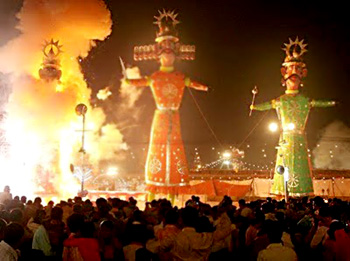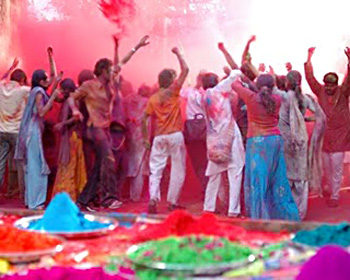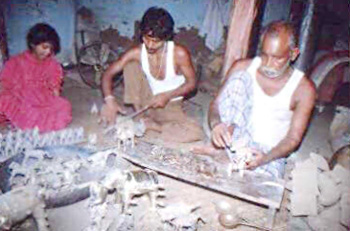 Culture of Narsinghpur district is an example of unity in great diversity. People belonging to different religious communities live with peace and harmony in the district of Narsinghpur. The Kshatriyas are the main class of people living in this district. The Kaurava, Kirar, Lodhi, Rajput and Gurjar classes of people are very hard working and live peacefully engaged in farming and agriculture. The society in Narsinghpur district comprises of mainly the Hindus, but even Muslims, Christians and people from other religions live with the feeling of brotherhood and unity. In this district, people respect all the religions. Festivals like Diwali, Holi, Id, Gurunanak Jayanti, Mahaveer Jayanti and Paryushan parva are celebrated with lot of pomp and glory. People love the story of Ramayana, and often Ramayana mandal, manas sammelans, religious lectures are organized in villages.
Culture of Narsinghpur district is an example of unity in great diversity. People belonging to different religious communities live with peace and harmony in the district of Narsinghpur. The Kshatriyas are the main class of people living in this district. The Kaurava, Kirar, Lodhi, Rajput and Gurjar classes of people are very hard working and live peacefully engaged in farming and agriculture. The society in Narsinghpur district comprises of mainly the Hindus, but even Muslims, Christians and people from other religions live with the feeling of brotherhood and unity. In this district, people respect all the religions. Festivals like Diwali, Holi, Id, Gurunanak Jayanti, Mahaveer Jayanti and Paryushan parva are celebrated with lot of pomp and glory. People love the story of Ramayana, and often Ramayana mandal, manas sammelans, religious lectures are organized in villages.
People in the district of Narsinghpur wear clothes like dhoti, kurta, bandi and put a piece of cloth on their shoulders which is called gamcha. In the rural as well as in urban areas people wear pant, shirt and pajama. However, people in villages with agricultural background generally put on dhoti and kurta. The food habits of the people of this district basically comprise vegetarian food, and there is not much liking towards non vegetarian food. About 75 percent of the population is engaged in farming or are agricultural labourers and the rest are engaged in small-scale industries or business or engaged in different jobs.
 Raksha Bandhan, Holi, Dussehra etc are the festivals which has got religious conviction and social importance. During Sawan, people dance while singing Serra and rachchre. In the month of Phagun on the occasion of holi, people sing rahi and fagi. At the time of Diwali, Aahir wear a special type costume made up of nets which is covered by peacocks feathers and Kaudies. After the worship of Gowardhana (Lord Krishna) Aahir dances and sings. On the occasion of tribal marriages men and women both perform Karma and Saitaan dance.
Raksha Bandhan, Holi, Dussehra etc are the festivals which has got religious conviction and social importance. During Sawan, people dance while singing Serra and rachchre. In the month of Phagun on the occasion of holi, people sing rahi and fagi. At the time of Diwali, Aahir wear a special type costume made up of nets which is covered by peacocks feathers and Kaudies. After the worship of Gowardhana (Lord Krishna) Aahir dances and sings. On the occasion of tribal marriages men and women both perform Karma and Saitaan dance.
As per the `Vikram Samvat Era`, Hindu calendar, Ramnavami is the first festival of the year which falls in the month of Chaitra which is of course the first moth of Hindu calendar. This is known as Nau-Durga because of nine days continuous worship of Goddess Durga along with fasting and growing Jaware. On the last day, on Navami, people take these Jaware with a procession and do Visarjana in different ponds and rivers. People celebrate the birthday of Lord Rama very grandly. In rural areas, Akhti festival has got an extra importance because from this day only agricultural year begins. This festival is celebrated on Vaishakh Sudi Akshay Tritiya. Shravan sudi has Nagpanchami festival. Kajaliyan celebrated on the second day after Rakshabandhan and in this festival people exchange kajaliyan with their friends and relatives.
 On Bhadra month Krishna Paksh`s sixth day, married women celebrate Harchat (Halashti), in which they wish for their children`s and husband`s safety and prosperity. Pola observed after fifteen days from Janmashtami i.e. on Pratipada when bullocks are worshiped. On Bhadra Sudi tritiya women do fasting (not even taking water) for twenty hours, which is called `Teeja` and on this day they worship Lord Shiva and Goddess Parvati and wishes for their her husband`s prosperity. Other major festivals are Diwali, Dusehrra, Rang Panchami and Holi celebrated with full traditional way and joy.
On Bhadra month Krishna Paksh`s sixth day, married women celebrate Harchat (Halashti), in which they wish for their children`s and husband`s safety and prosperity. Pola observed after fifteen days from Janmashtami i.e. on Pratipada when bullocks are worshiped. On Bhadra Sudi tritiya women do fasting (not even taking water) for twenty hours, which is called `Teeja` and on this day they worship Lord Shiva and Goddess Parvati and wishes for their her husband`s prosperity. Other major festivals are Diwali, Dusehrra, Rang Panchami and Holi celebrated with full traditional way and joy.
Dhoti kurta, dhoti kameez, bandi and gamcha on shoulder are the main dress men wear in rural areas. Kaste sarees are very common among rural women while in towns and cities trousers, shirts and suits are in fashion. Working women wear salwar suits. In general, people love to have gold and silver. Ornaments made up of silver and gold like laung, chain, nathani, finger-ring, ear ring, mangalsutra, kardhan, comb, bankada, todal, lachche, payal, bichiya and machali are very common and in fashion.
The most common tradition in this district is called Godana. It is very common and popular among the tribal women and children. Women believe that this is compulsory for their well being and a way of beauty treatment. Godana is an activity which is done by the help of needles inked by some solutions called `shusish` designs, letters and impressions are made permanently on the body. This is a true evidence of the creativity and fantasy of the tribal people in their artistic skills.
Residents of Narsinghpur district in the state of Madhya Pradesh are very hard working and peace loving. People respect each others` caste, religion, customs and traditions. They celebrate each others` festivals with full communal harmony and unity which clearly states the unity in diversity. The primary language of the district is Hindi but the local language known as Narsinghpuria is very popular.



















